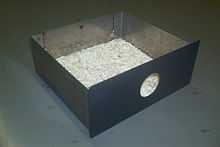Bit bucket
In computing, the bit bucket is jargon for where lost computerized data has gone, by any means; any data which does not end up where it is supposed to, being lost in transmission, a computer crash, or the like, is said to have gone to the bit bucket — that mysterious place on a computer where lost data goes, as in:
The errant byte, having failed the parity test, is unceremoniously dumped into the bit bucket, the computer's wastepaper basket.
Millions of dollars in time and research data gone into the bit-bucket?

Originally, the bit bucket was the container on Teletype machines or IBM key punch machines into which chad from the paper tape punch or card punch was deposited;[3] the formal name is "chad box" or (at IBM) "chip box".
The term was then generalized into any place where useless bits go. In Unix and Unix-like operating systems, this term is used to refer to /dev/null. On HP OpenVMS, this term refers to device "NLA0:" ("NL:" may also be used). The same Univac 90/60 operating systems such as VS/9, it referred to "*DUMMY". On the DEC PDP-11, the bit bucket is "NL:". On DOS and Windows CMD, it is the "NUL" device, or simply "$null" in PowerShell.
The bit bucket is also used in discussions of bit shift operations.[4] When the width of a given binary number is fixed, one or more bits are lost when performing a simple shift. These bits are said to have "fallen off" or to have "fallen into the bit bucket". Some CPUs move the last bit shifted off the end of a number during a shift into the carry flag during some or all shift operations; since the bit bucket is usually considered the place where discarded (and therefore lost) bits go, the carry flag in this case would probably be excluded from the bit bucket—unless, perhaps, the speaker intended to ignore the bit saved in the carry flag and treat it as though it had been truly discarded.
Such a device is sometimes referred to as a "write once read never" or WORN device (named after the magneto-optical WORM devices used during the 80s), and was indeed implemented as such as an Easter egg in early versions of Atari BASIC.
The WORN device is related to the First In Never Out stack and Write Only Memory, in a joke datasheet issued by Signetics in 1972.
In programming languages the term is used to denote a bitstream which does not consume any computer resources such as CPU or memory, by discarding any data "written" to it. In .NET Framework-based languages, it is the System.IO.Stream.Null.[5]
See also
| Look up bit bucket in Wiktionary, the free dictionary. |
- Black hole (Unix jargon)
- /dev/null
- Null route (Cisco jargon)
References
- ↑ Sandberg-Diment, Erik (July 9, 1985). "Parity: An Elegantly Simple Approach to Errors". New York Times (New York, N.Y.: New York Times Company). Retrieved 08 November 2013.
- ↑ Blase, W. Paul (Feb. 17 1990). "No Harmless Hacker He". The Washington Post (Washington, D.C.: The Washington Post Company). Retrieved 08 November 2013.
- ↑ Cutler, Donald I. (1964). Introduction to Computer Programming. Prentice-Hall. p. 108. Retrieved 08 November 2013. "The lost bits fall into a container called a bit bucket. They are emptied periodically and the collected bits are used for confetti at weddings, parties, and other festive occasions."
- ↑ O'Brien, Frank (2010). The Apollo Guidance Computer: Architecture and Operation. Springer. p. 45. ISBN 9781441908773. Retrieved 08 November 2013.
- ↑ "Using null stream as bit bucket" — an article on C# at java2s.org.
External links
- Bit Bucket entry from The Jargon File (version 4.4.7)
- A "Write Once Read Never" device available on Atari 8-bit hardware